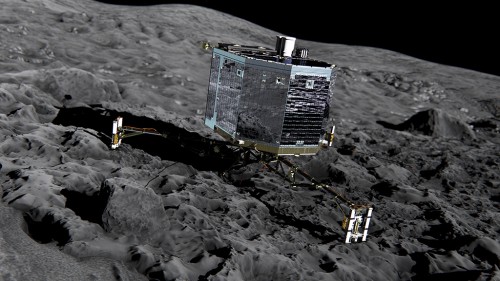
Here comes the Sun: the Philae lander may reawaken soon. (Courtesy: ESA/ATG medialab)
By Michael Banks
Scientists at the European Space Agency (ESA) are hoping that the Philae lander, which successfully landed on a comet last year, will re-establish contact soon as it travels closer to the Sun. Philae was part of ESA’s Rosetta mission that was launched in 2004 but when Philae separated from Rosetta in November, it landed on the comet in an awkward position. This meant that the craft’s solar panels did not receive enough sunlight to recharge its battery, but the lander’s 10 instruments were able to carry out measurements before it went into hibernation mode about 50 hours after landing.
At a press conference this week at the European Geosciences Union General Assembly in Vienna, Austria, Philae lander manager Stephan Ulamec said that the agency had a “good understanding” of where Philae may be after it bounced twice during a bumpy landing but could not identify its exact location from images taken by Rosetta. “The more wine you drink, the more landers you are able to identify in this terrain,” he noted. “But we have some good candidates.”
Ulamec says that although the lander is not anchored, it is firmly on the surface, possibly down a hole, adding that there is no risk of it being “blown away”. He says that the craft’s solar panels are getting more light each day as the comet gets closer to the Sun. Indeed, mission controllers have begun to turn on Rosetta’s receiver, but have not yet received a signal from Philae.
Ulamec adds that Philae should get sufficient power – around 19 W – by this month to start the rebooting process. Once that is complete, then it is hoped that the lander will begin to make contact with Rosetta, which could happen this month or next. After that, scientists hope there will then be enough sunlight to start recharging the battery sometime in July. This would bring Philae’s instruments back into use again. However, with the temperature being about –45 °C, scientists can only hope that Philae’s solar modules do not remain cast in a shadow so that any light would only go towards heating the craft and not providing power.
Uranus has a gassy atmosphere
Perhaps they should have painted the top of the device orange or red to provide a ‘here I am’ sign discernible from afar 😉